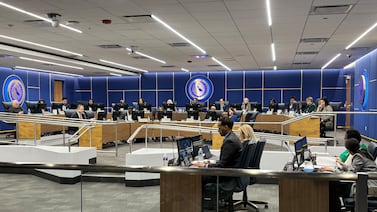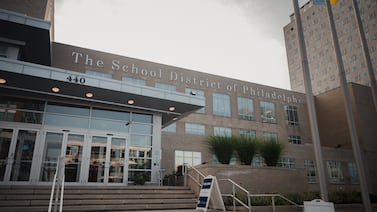Sign up for Chalkbeat New York’s free daily newsletter to get essential news about NYC’s public schools delivered to your inbox.
New York City schools with fewer students than projected will not have to give back money midyear, Education Department officials announced Monday, as the public school system saw its biggest enrollment drop in four years.
Enrollment in the city’s K-12 and preschool programs fell by about 22,000, or 2.4%, compared to last year, according to the Education Department’s preliminary numbers. A total of 884,400 students were enrolled in the city’s traditional public schools as of Oct. 31, according to the figures.
Nearly two-thirds of the city’s roughly 1,600 schools had fewer students than projected, officials said. In past years, those schools would have had to pay back a total of more than $250 million to the city. But those funds will now stay with schools.
“As we navigate enrollment fluctuations and uncertainty around federal funding, we’re committed to providing stability and ensuring every school has the resources it needs,” schools Chancellor Melissa Aviles-Ramos said in a statement.
The remaining third of schools whose enrollment was higher than projected will receive extra money to account for the additional students, officials said, but didn’t say how much that will cost.
In some ways, Mayor Eric Adams’ parting gift to schools could become a headache for the next mayor, who will have to confront the costly but popular initiative.
City officials did not immediately offer an explanation for the enrollment drop, but it’s likely that changing immigration patterns played a role. Over the three school years prior to this one, city schools absorbed an influx of roughly 50,000 migrant students.
That surge helped offset declining enrollment, keeping the city’s student numbers relatively flat between 2022 and 2024. But immigration into the country and city has ground to a halt under President Donald Trump’s enforcement efforts. Adams has closed many of the emergency shelters the city opened to house migrants.
Several educators at schools with large immigrant populations have noticed sharp enrollment declines this year, driven by existing students leaving and fewer new ones showing up.
“We definitely have seen a decline this year in our schools that serve newcomers,” said John Sullivan, the superintendent overseeing transfer schools geared toward older high school students, at a hearing last week with the City Council.
Manhattan’s Liberty High School Academy for Newcomers is down about 200 students this year compared to its average enrollment in recent years, Sullivan said. More students learning English are dropping out of school early to take jobs, he said.
ELLIS Prep, another high school in the Bronx geared toward older newcomers, has also seen slower enrollment this year, Principal Norma Vega said. The school is down about 30 students from last year and roughly 20 students under its projection for this year. That meant Vega would have had to pay back roughly $333,000 if the city had followed through with the midyear clawback.
Keeping that money will allow her to continue funding field trips, computers for students, and extra tutoring, she said.
Vega already missed the deadline for this school year to cut teachers, which means she would have started next school year with a deficit and likely would have lost her English as a New Language coordinator, one of her newest hires.
“It’s a blessing” to not have to pay back the funds midyear, Vega said.
Before the pandemic, schools typically had to give money back to the city during the middle of the school year if they enrolled fewer students than projected. (Those that enrolled more students would get extra funds midyear.)
The policy to keep school budgets afloat despite enrollment, known as being “held harmless,” was initially enacted during the pandemic when many schools saw their rosters dwindle but had mounting needs to support students academically and emotionally.
Enrollment citywide has been on the decline for a decade, but went into freefall during the pandemic, dropping by nearly 100,000 students. This year’s enrollment decline is the largest since the 2021-22 school year, when enrollment fell by around 36,000 students, or 3.8%, from the previous year.
The city halted the hold harmless policy in the 2023-24 school year only to bring it back last year.
Last school year, the decision not to claw back school budgets midyear meant schools hung onto $157 million they would have otherwise had to give back. City officials committed a separate $126 million in June to ensure that no schools started out this school year with less funding than they had at the start of last school year.
This year’s total is far larger, given the steeper enrollment decline.
Emily Paige, the principal of Urban Assembly Unison, a small Brooklyn middle school, said she was on the hook for roughly $100,000 because of enrollment losses — enough to cover an entire teacher salary.
While the hold harmless policy is widely popular among school staff and families, it can be an unsustainable practice, some observers say, artificially inflating schools’ budgets and creating even more difficult financial decisions down the road as the city confronts increasingly expensive small schools.
The union representing principals, the Council for School Administrators, or CSA, claimed the move as a victory for its members, saying in an email to principals on Sunday its “top priority” this year has been ensuring the city kept its promise to hold schools harmless.
Michael Elsen-Rooney is a reporter for Chalkbeat New York, covering NYC public schools. Contact Michael at melsen-rooney@chalkbeat.org.
Amy Zimmer is the bureau chief for Chalkbeat New York. Contact Amy at azimmer@chalkbeat.org.





